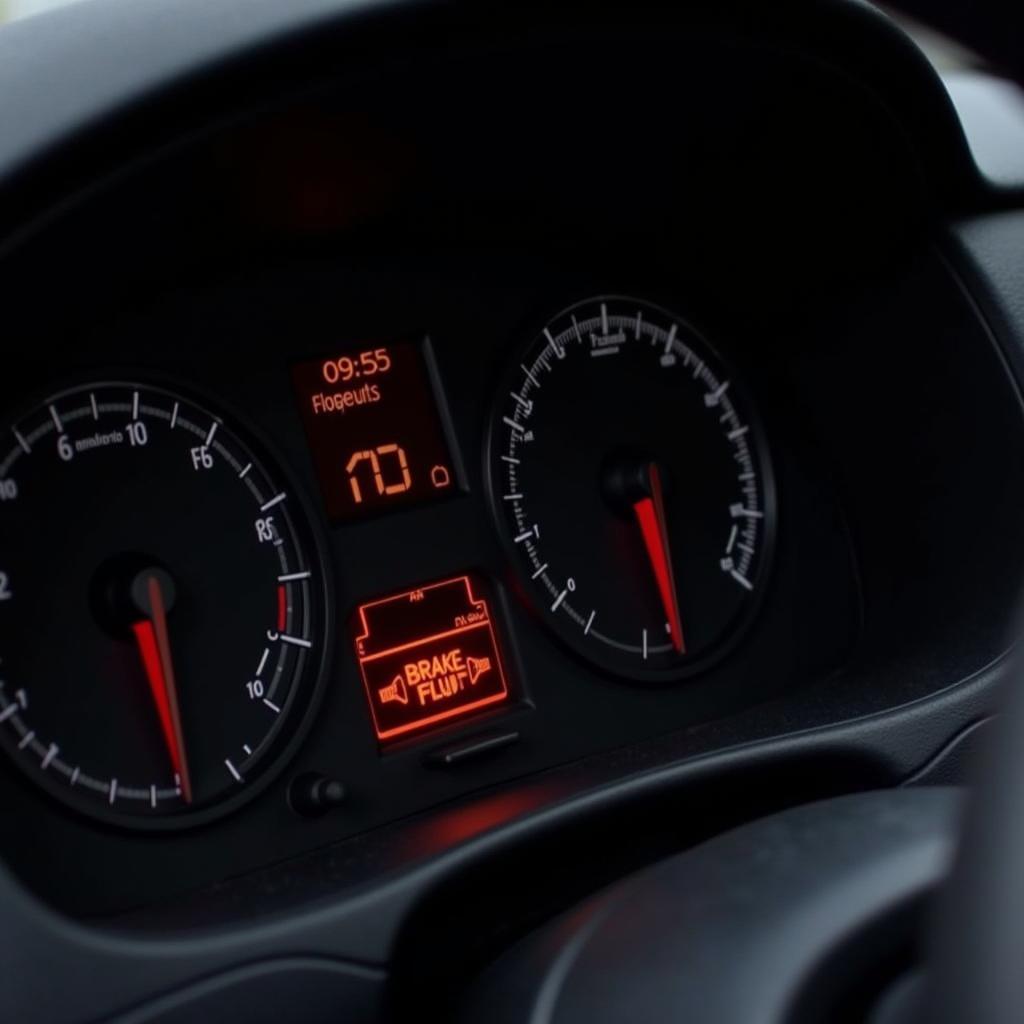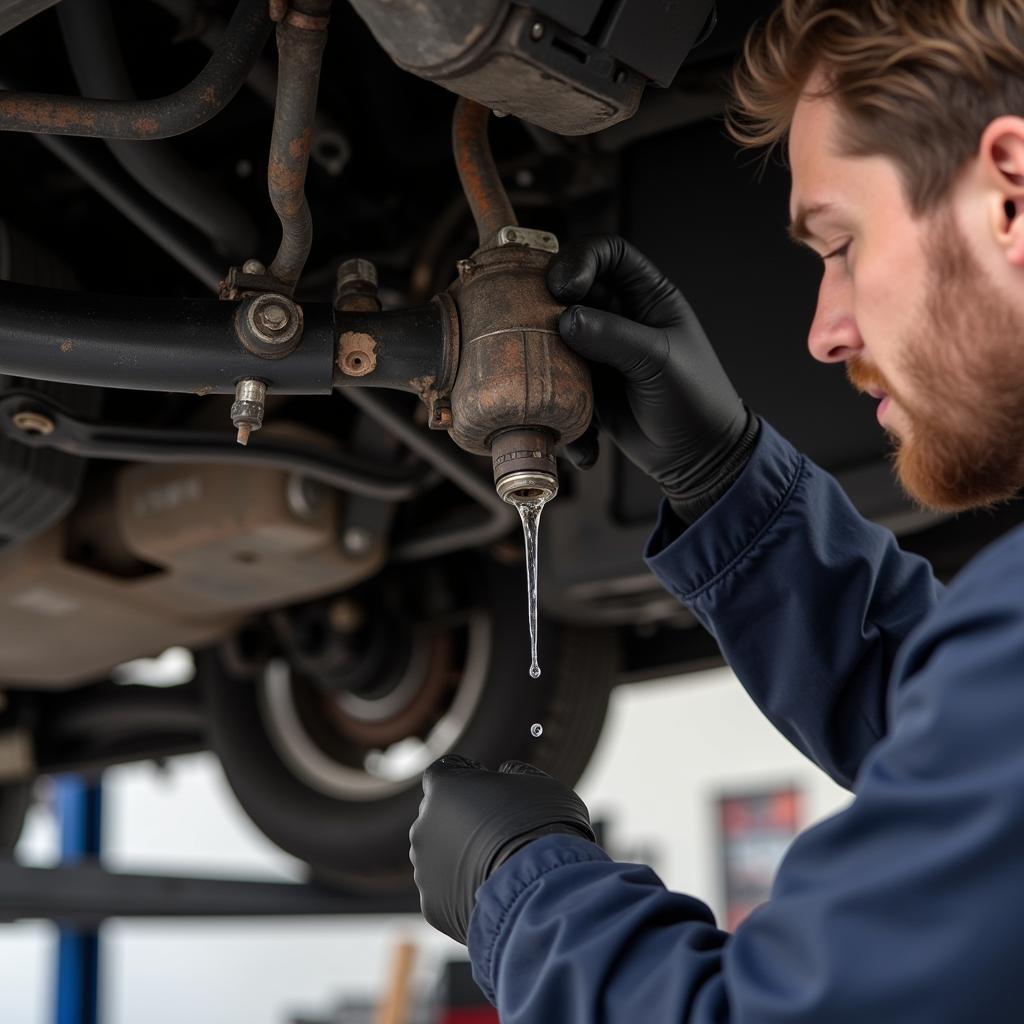The brake fluid warning light on your VW Polo dashboard is a crucial safety indicator that should never be ignored. This light, often depicted as a circle with parentheses and exclamation mark inside, illuminates to signal a potential problem with your braking system. This article delves into the common causes of a brake fluid warning light on a VW Polo and provides practical solutions for resolving the issue.
Understanding the Brake Fluid Warning Light
Your VW Polo’s braking system operates on hydraulic pressure created by brake fluid. When you press the brake pedal, this pressure is transmitted through the brake lines, activating the calipers and pushing the brake pads against the rotors to slow down or stop the vehicle. The brake fluid warning light acts as a sentinel, alerting you to a drop in this crucial fluid pressure. Ignoring this warning could lead to reduced braking efficiency, making your vehicle unsafe to drive.
 VW Polo brake fluid warning light on dashboard
VW Polo brake fluid warning light on dashboard
Common Causes of a Brake Fluid Warning Light on a VW Polo
Several factors can trigger the brake fluid warning light in your VW Polo:
- Low Brake Fluid Level: The most common culprit is insufficient brake fluid. Brake fluid naturally depletes over time due to wear and tear on the brake pads. If the fluid level drops below the minimum, the warning light will illuminate.
- Worn Brake Pads: As your brake pads wear down, the calipers need to extend further to engage the rotors. This extension requires more brake fluid, potentially triggering the warning light.
- Brake Fluid Leak: A leak anywhere within the braking system, including brake lines, hoses, calipers, or the master cylinder, can result in a loss of pressure and activate the warning light.
- Faulty Brake Fluid Level Sensor: While less common, a malfunctioning brake fluid level sensor can send a false signal, causing the warning light to illuminate even if the fluid level is adequate.
 Brake fluid leak in a VW Polo
Brake fluid leak in a VW Polo
What to Do When Your VW Polo’s Brake Fluid Warning Light Comes On
If the brake fluid warning light illuminates while driving, it’s crucial to act immediately:
- Safely pull over: Find a safe location to park your car away from traffic.
- Check the brake fluid level: With the engine off, carefully open the hood and locate the brake fluid reservoir. It’s usually a translucent container with a black cap, labeled “Brake Fluid.”
- Add brake fluid (if necessary): If the fluid level is below the minimum mark, carefully top it off with the correct DOT specification brake fluid recommended in your VW Polo’s owner’s manual.
- Inspect for leaks: While adding fluid or if the level seems adequate, thoroughly examine the area around the reservoir, brake lines, and under the car for any signs of leakage. Look for wet spots or drips of fluid.
Important: If you notice a leak, the fluid level is extremely low, or you are uncomfortable performing these steps, do not attempt to drive your car. Instead, contact a qualified mechanic or towing service to avoid potential hazards.
Professional Diagnosis and Repair
While adding brake fluid might temporarily address a low fluid level, it is crucial to determine the underlying cause of the problem. A professional mechanic possesses the expertise and tools to accurately diagnose and repair the issue. They can:
- Identify the root cause: Through a thorough inspection, a mechanic can pinpoint the source of the problem, whether it’s worn brake pads, a fluid leak, or a faulty sensor.
- Perform necessary repairs: From replacing worn brake components to repairing leaks and replacing faulty sensors, a mechanic can restore your braking system to optimal functionality.
- Ensure safety and reliability: By addressing the underlying issue, a professional repair ensures the safety and reliability of your VW Polo’s braking system, giving you peace of mind on the road.
Preventive Measures
Preventing brake fluid issues involves regular maintenance and inspections:
- Regular Brake Fluid Flushes: Consult your VW Polo’s owner’s manual for the recommended brake fluid flush intervals. This service involves replacing old fluid with fresh fluid, preventing contamination and maintaining optimal braking performance.
- Brake Pad Inspections: During routine maintenance checks, have your mechanic inspect the condition of your brake pads. Replacing worn brake pads promptly can prevent further issues and contribute to the longevity of your braking system.
- Visual Inspections: Make it a habit to visually inspect your VW Polo’s brake fluid level regularly. This simple check can help you detect potential issues early on.
 Mechanic inspecting the brakes of a VW Polo
Mechanic inspecting the brakes of a VW Polo
Conclusion
A glowing brake fluid warning light in your VW Polo should never be ignored. Understanding its significance and the potential causes can help you take prompt action. While adding brake fluid can be a temporary solution, a professional diagnosis and repair are essential for ensuring the safety and reliability of your vehicle’s braking system. Regular maintenance and inspections play a vital role in preventing future issues and ensuring optimal braking performance. Remember, a well-maintained braking system is paramount for your safety and the safety of others on the road.
